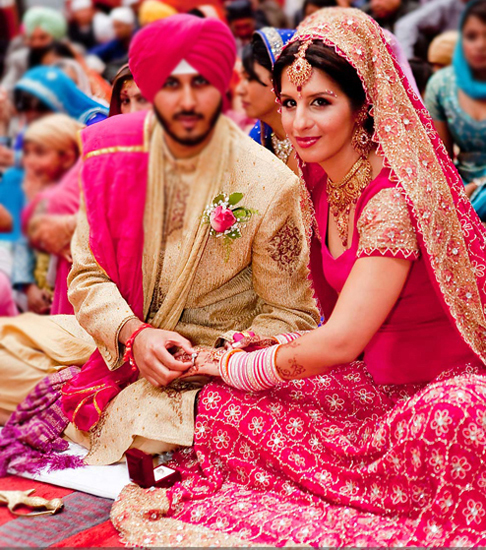Kharti community basically belongs to Punjab state. Their wedding rituals are more or less similar to Punjabi wedding rituals. The people of this community like to marry their son or daughter within the community. They are Khatri brides and groom within their community. Their wedding rituals are full of life, excitement and enthusiasm. Let’s take a look at some of the wedding rituals of Khatri community.
Sagaai: Once the alliance is accepted between the families of Khatri boy and girl for marriage, the family members and close relatives of the bride go to groom’s house with fruits, gift, sweets and other things to confirm this new relationship. The elder members of the bride’s family apply tilak on groom’s forehead and offer him gifts, clothes and sweets. This whole ceremony is known as Sagaai in khatri community.
Godh Bharai: This ritual is generally conducted two or three days prior to the wedding. The groom’s family and relatives visit the bride’s house with gifts, dry fruits, sweets, jewelry, clothes and other things. The mother and other elder ladies of the family offer all these things to would-be-bride. The groom’s mother places silver platters containing all these gifts in the lap of the bride. They also apply tilak on her forehead.
Kangna: This ritual is conducted in both bride’s and groom’s family. The pujari performs all the rituals related to this important ceremony. He ties a sacred red thread on the hand of bride/groom which contains betel nuts, tamarind and tiny shells. This is generally done to protect the bride/groom from the ill/negative powers and all the rituals of the marriage end peacefully. They are supposed to keep it on their hands till the end of all wedding rituals.
Mehendi: This ceremony is performed in both the houses. The heena is applied on the hands and feet of bride by the mehendi artist. All the females of the family also apply heena on their hands. This is really important ceremony. Heena is important and has its relevance too. As per a common belief, if the color of the bride’s mehendi is really dark, then her husband/mother-in-law will love her more.
Sedhe hath tanni kadhai: This ceremony is also conducted in both the families wherein the relatives and family members of both the family apply paste of besan paste made by mustard oil, fresh milk, curd and turmeric. The paste is applied on face, shoulders, hands and feet of the couple. After this ceremony they take the bath.
Chuda ceremony: In this ceremony, the bride’s maternal uncle and aunt slip a set of red chuda bangles on bride’s wrist after a puja is done by the priest. She receives blessing by all the family members after this ceremony.
Sehrabandi and Ghodi chadhna: An elderly male of the groom’s family tie the veil on the forehead of the groom. This ceremony is known as sehrabandi. The next ritual is Ghodi chadhna, after which the groom’s family proceeds with baraat towards the wedding venue.
Varmala: After reaching the venue the bride and groom exchange the garland as ritual, it is known as varmala ceremony. After this, rest of the ceremonies takes place.
Kanyadan: After the vermala ceremony, the bride and groom is taken to the mandap, where father of the bride performs kandyadan ceremony. This is followed by the mangalsutra ceremony in front of the sacred fire.
LoveVivah.com Khatri Matrimony site gives birdes and grooms of Khatri for wedding. Select your future spouse from the latest Punjabi matrimonial profiles.

